Influence of Oxide Dispersions (Al2O3, TiO2, and Y2O3) in CrFeCuMnNi High-Entropy Alloy on Microstructural Changes and Corrosion Resistance
Abstract
:1. Introduction
2. Materials and Methods
2.1. Synthesis and Consolidation of ODS-HECs
2.2. Electrochemical Experiments
2.3. Materials Characterization
3. Results and Discussion
3.1. HRSEM and XRD Analyses on As-Received Elemental Powders
3.2. XRD and HRSEM Phase Analyses on ODS-HECs
3.3. Electrochemical Corrosion Behavior of ODS-HECs
3.3.1. Cyclic Potentiodynamic Polarization (CPP) Data
3.3.2. Electrochemical Impedance Spectroscopy (EIS) Measurements
3.3.3. Chronoamperometric Current–Time (CCT) Measurements
3.4. Corrosion Surface Morphology Examination
4. Conclusions
Author Contributions
Funding
Data Availability Statement
Acknowledgments
Conflicts of Interest
References
- Phaniraj, M.P.; Kim, D.I.; Shim, J.H.; Cho, Y.W. Microstructure development in mechanically alloyed yttria dispersed austenitic steels. Acta Mater. 2009, 57, 1856–1864. [Google Scholar] [CrossRef]
- Klueh, R.L. Elevated temperature ferritic and martensitic steels and their application to future nuclear reactors. Int. Mater. Rev. 2005, 50, 287–310. [Google Scholar] [CrossRef] [Green Version]
- Ukai, S.; Fujiwara, M. Perspective of ODS alloys application in nuclear environments. J. Nucl. Mater. 2002, 307–311, 749–757. [Google Scholar] [CrossRef]
- Cheng, Y.; Thow, Z.; Wang, C.-H. Biomass gasification with CO2 in a fluidized bed. Powder Technol. 2016, 296, 87–101. [Google Scholar] [CrossRef]
- George, E.P.; Raabe, D.; Ritchie, R.O. High-entropy alloys. Nat. Rev. Mater. 2019, 4, 515–534. [Google Scholar] [CrossRef]
- Nagase, T.; Rack, P.D.; Noh, J.H.; Egami, T. In-situ TEM observation of structural changes in nano-crystalline CoCrCuFeNi multicomponent high-entropy alloy (HEA) under fast electron irradiation by high voltage electron microscopy (HVEM). Intermetallics 2015, 59, 32–42. [Google Scholar] [CrossRef] [Green Version]
- Chen, R.; Qin, G.; Zheng, H.; Wang, L.; Su, Y.; Chiu, Y.; Ding, H.; Guo, J.; Fu, H. Composition design of high entropy alloys using the valence electron concentration to balance strength and ductility. Acta Mater. 2018, 144, 129–137. [Google Scholar] [CrossRef]
- Wu, Z.; Bei, H.; Pharr, G.M.; George, E.P. Temperature dependence of the mechanical properties of equiatomic solid solution alloys with face-centered cubic crystal structures. Acta Mater. 2014, 81, 428–441. [Google Scholar] [CrossRef]
- Praveen, S.; Basu, J.; Kashyap, S.; Kottada, R.S. Exceptional resistance to grain growth in nanocrystalline CoCrFeNi high entropy alloy at high homologous temperatures. J. Alloys Compd. 2016, 662, 361–367. [Google Scholar] [CrossRef]
- Wu, W.; Zhou, R.; Wei, B.; Ni, S.; Liu, Y.; Song, M. Nanosized precipitates and dislocation networks reinforced C-containing CoCrFeNi high-entropy alloy fabricated by selective laser melting. Mater. Charact. 2018, 144, 605–610. [Google Scholar] [CrossRef]
- Vaidya, M.; Anupam, A.; Bharadwaj, J.V.; Srivastava, C.; Murty, B.S. Grain growth kinetics in CoCrFeNi and CoCrFeMnNi high entropy alloys processed by spark plasma sintering. J. Alloys Compd. 2019, 791, 1114–1121. [Google Scholar] [CrossRef]
- Koch, C.C. Nanocrystalline high-entropy alloys. J. Mater. Res. 2017, 32, 3435–3444. [Google Scholar] [CrossRef] [Green Version]
- Wang, P.; Cai, H.; Zhou, S.; Xu, L. Processing, microstructure and properties of Ni1.5CoCuFeCr0.5-xVx high entropy alloys with carbon introduced from process control agent. J. Alloys Compd. 2017, 695, 462–475. [Google Scholar] [CrossRef]
- Gludovatz, B.; Hohenwarter, A.; Catoor, D.; Chang, E.H.; George, E.P.; Ritchie, R.O. A fracture-resistant high-entropy alloy for cryogenic applications. Science 2014, 345, 1153–1158. [Google Scholar] [CrossRef] [Green Version]
- Nagini, M.; Vijay, R.; Rajulapati, K.V.; Reddy, A.V.; Sundararajan, G. Microstructure–mechanical property correlation in oxide dispersion strengthened 18Cr ferritic steel. Mater. Sci. Eng. A 2017, 708, 451–459. [Google Scholar] [CrossRef]
- Oono, N.; Ukai, S.; Kondo, S.; Hashitomi, O.; Kimura, A. Irradiation effects in oxide dispersion strengthened (ODS) Ni-base alloys for Gen. IV nuclear reactors. J. Nucl. Mater. 2015, 465, 835–839. [Google Scholar] [CrossRef]
- Prasad, H.; Singh, S.; Panigrahi, B.B. Mechanical activated synthesis of alumina dispersed FeNiCoCrAlMn high entropy alloy. J. Alloys Compd. 2017, 692, 720–726. [Google Scholar] [CrossRef]
- Hadraba, H.; Chlup, Z.; Dlouhy, A.; Dobes, F.; Roupcova, P.; Vilemova, M.; Matejicek, J. Oxide dispersion strengthened CoCrFeNiMn high-entropy alloy. Mater. Sci. Eng. A 2017, 689, 252–256. [Google Scholar] [CrossRef]
- Gwalani, B.; Pohan, R.M.; Lee, J.; Lee, B.; Banerjee, R.; Ryu, H.J.; Hong, S.H. High-entropy alloy strengthened by in situ formation of entropy-stabilized nano-dispersoids. Sci. Rep. 2018, 8, 14085. [Google Scholar] [CrossRef] [Green Version]
- Liu, X.; Yin, H.; Xu, Y. Microstructure, mechanical and tribological properties of Oxide Dispersion Strengthened high-entropy alloys. Materials 2017, 10, 1312. [Google Scholar] [CrossRef] [PubMed] [Green Version]
- Jia, B.; Liu, X.J.; Wang, H.; Wu, Y.; Lu, Z.P. Microstructure and mechanical properties of FeCoNiCr high-entropy alloy strengthened by nano-Y2O3 dispersion. Sci. China Technol. Sci. 2018, 61, 179–183. [Google Scholar] [CrossRef]
- Yang, S.; Zhang, Y.; Yan, X.; Zhou, H.; Pi, J.; Zhu, D. Deformation twins and interface characteristics of nano-Al2O3 reinforced Al0.4FeCrCo1.5NiTi0.3 high entropy alloy composites. Mater. Chem. Phys. 2018, 210, 240–244. [Google Scholar] [CrossRef]
- Sherif, E.-S.M. Corrosion inhibition in 2.0 M sulfuric acid solutions of high strength maraging steel by aminophenyl tetrazole as a corrosion inhibitor. Appl. Surf. Sci. 2014, 292, 190–196. [Google Scholar] [CrossRef]
- Sivasankaran, S.; Ammar, H.R.; Al-Mufadi, F.A. Continuous hot-compaction behavior of nanostructured FeCrCuMnTi-(V, Zn) high-entropy alloys. Mater. Manuf. Process. 2022, 37, 1122–1131. [Google Scholar] [CrossRef]
- Qin, G.; Wang, S.; Chen, R.; Zheng, H.; Wang, L.; Su, Y.; Guo, J.; Fu, H. Improvement of microstructure and mechanical properties of CoCrCuFeNi high-entropy alloys by V addition. J. Mater. Eng. Perform. 2019, 28, 1049–1056. [Google Scholar] [CrossRef]
- Habib, K.A.; Saura, J.J.; Ferrer, C.; Damra, M.S.; Giménez, E.; Cabedo, L. Comparison of flame sprayed Al2O3/TiO2 coatings: Their microstructure, mechanical properties and tribology behavior. Surf. Coat. Technol. 2006, 201, 1436–1443. [Google Scholar] [CrossRef]
- Zhang, C.; Yang, Y.; Miao, L.; Ma, Y.; Zhang, X.; Cui, Y.; Dong, Y.; Chen, X.; Wang, L.; Liu, Z. Microstructure and properties of Al2O3-Y2O3 ceramic composite coatings fabricated by plasma spraying. Surf. Coat. Technol. 2018, 350, 550–559. [Google Scholar] [CrossRef]
- Zhao, Q.; Pan, Z.; Wang, X.; Luo, H.; Liu, Y.; Li, X. Corrosion and passive behavior of AlxCrFeNi3−x (x = 0.6, 0.8, 1.0) eutectic high entropy alloys in chloride environment. Corros. Sci. 2022, 208, 110666. [Google Scholar] [CrossRef]
- Ma, Y.; Jiang, B.; Li, C.; Wang, Q.; Dong, C.; Liaw, P.K.; Xu, F.; Sun, L. The BCC/B2 morphologies in AlxNiCoFeCr high-entropy alloys. Metals 2017, 7, 57. [Google Scholar] [CrossRef] [Green Version]
- Huo, W.; Zhou, H.; Fang, F.; Xie, Z.; Jiang, J. Microstructure and mechanical properties of CoCrFeNiZrx eutectic high-entropy alloys. Mater. Des. 2017, 134, 226–233. [Google Scholar] [CrossRef]
- Chen, X.; Qi, J.Q.; Sui, Y.W.; He, Y.Z.; Wei, F.X.; Meng, Q.K.; Sun, Z. Effects of aluminum on microstructure and compressive properties of Al-Cr-Fe-Ni eutectic multi-component alloys. Mater. Sci. Eng. A 2017, 681, 25–31. [Google Scholar] [CrossRef]
- Sherif, E.-S.M.; Ahmed, A.H. Alleviation of Iron Corrosion in Chloride Solution by N, N′-bis [2-Methoxynaphthylidene] amino] oxamide as a Corrosion Inhibitor. Crystals 2021, 11, 1516. [Google Scholar] [CrossRef]
- Sherif, E.-S.M. Electrochemical investigations on the corrosion inhibition of aluminum by 3-amino-1, 2, 4-triazole-5-thiol in naturally aerated stagnant seawater. J. Ind. Eng. Chem. 2013, 19, 1884–1889. [Google Scholar] [CrossRef]
- Lagrenee, M.; Mernari, B.; Bouanis, M.; Traisnel, M.; Bentiss, F. Study of the mechanism and inhibiting efficiency of 3, 5-bis (4-methylthiophenyl)-4H-1, 2, 4-triazole on mild steel corrosion in acidic media. Corros. Sci. 2002, 44, 573–588. [Google Scholar] [CrossRef]
- Musa, A.Y.; Khadom, A.A.; Kadhum, A.A.H.; Mohamad, A.B.; Takriff, M.S. Kinetic behavior of mild steel corrosion inhibition by 4-amino-5-phenyl-4H-1, 2, 4-trizole-3-thiol. J. Taiwan Inst. Chem. Eng. 2010, 41, 126–128. [Google Scholar] [CrossRef]
- Banerjee, S.N.; Misra, S. 1, 10,-phenanthroline as corrosion inhibitor for mild steel in sulfuric acid solution. Corrosion 1989, 45, 780–783. [Google Scholar] [CrossRef]
- Ma, H.; Chen, S.; Niu, L.; Zhao, S.; Li, S.; Li, D. Inhibition of copper corrosion by several Schiff bases in aerated halide solutions. J. Appl. Electrochem. 2002, 32, 65–72. [Google Scholar] [CrossRef]
- Mansfeld, F.; Lin, S.; Kim, K.; Shih, H. Pitting and surface modification of SIC/Al. Corros. Sci. 1987, 27, 997–1000. [Google Scholar] [CrossRef]
- Burduhos-Nergis, D.-P.; Vizureanu, P.; Sandu, A.V.; Bejinariu, C. Evaluation of the corrosion resistance of phosphate coatings deposited on the surface of the carbon steel used for carabiners manufacturing. Appl. Sci. 2020, 10, 2753. [Google Scholar] [CrossRef] [Green Version]
- González, F.; Greiner, D.; Mena, V.; Souto, R.M.; Santana, J.J.; Aznárez, J.J. Fitting procedure based on Differential Evolution to evaluate impedance parameters of metal—Coating systems. Eng. Comput. 2019, 36, 2960–2982. [Google Scholar] [CrossRef]
- Musa, M.; Purwanto, H.; Razak, R.; Othman, R.; Musa, L.; Ani, M.H. Electrochemical Impedance Spectroscopy (EIS) Study of Coconut Water as Natural Inhibitor in Malay Traditional Preservation of Iron Artefact. In IOP Conference Series: Materials Science and Engineering; IOP Publishing: Bristol, UK, 2020; Volume 864, p. 12034. [Google Scholar]
- Lan, Y.; Chang, H.; Qi, G.; Han, P.; He, B. The Electrochemical Corrosion Behaviour of Q235 Steel in Soil Containing Sodium Chloride. Int. J. Electrochem. Sci. 2021, 16, 210925. [Google Scholar] [CrossRef]
- Zhang, Z.; Chen, S.; Li, Y.; Li, S.; Wang, L. A study of the inhibition of iron corrosion by imidazole and its derivatives self-assembled films. Corros. Sci. 2009, 51, 291–300. [Google Scholar] [CrossRef]
- Meng, G.; Wei, L.; Zhang, T.; Shao, Y.; Wang, F.; Dong, C.; Li, X. Effect of microcrystallization on pitting corrosion of pure aluminium. Corros. Sci. 2009, 51, 2151–2157. [Google Scholar] [CrossRef]
- Şafak, S.; Duran, B.; Yurt, A.; Türkoğlu, G. Schiff bases as corrosion inhibitor for aluminium in HCl solution. Corros. Sci. 2012, 54, 251–259. [Google Scholar] [CrossRef]
- Latief, F.H.; Sherif, E.-S.M.; Almajid, A.A.; Junaedi, H. Fabrication of exfoliated graphite nanoplatelets-reinforced aluminum composites and evaluating their mechanical properties and corrosion behavior. J. Anal. Appl. Pyrolysis 2011, 92, 485–492. [Google Scholar] [CrossRef]
- Cui, P.; Bao, Z.; Liu, Y.; Zhou, F.; Lai, Z.; Zhou, Y.; Zhu, J. Corrosion behavior and mechanism of dual phase Fe1.125Ni1.06CrAl high entropy alloy. Corros. Sci. 2022, 201, 110276. [Google Scholar] [CrossRef]
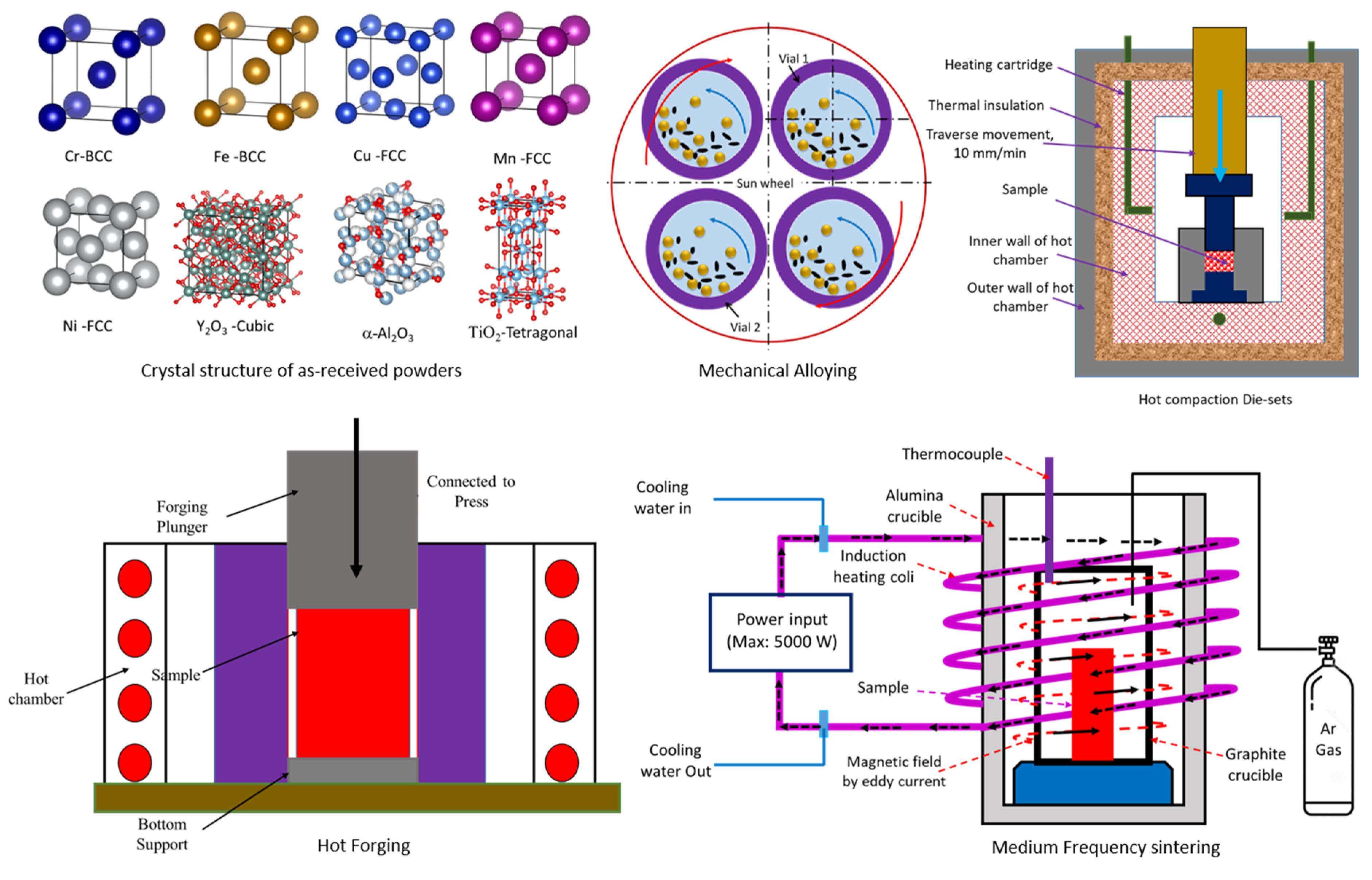
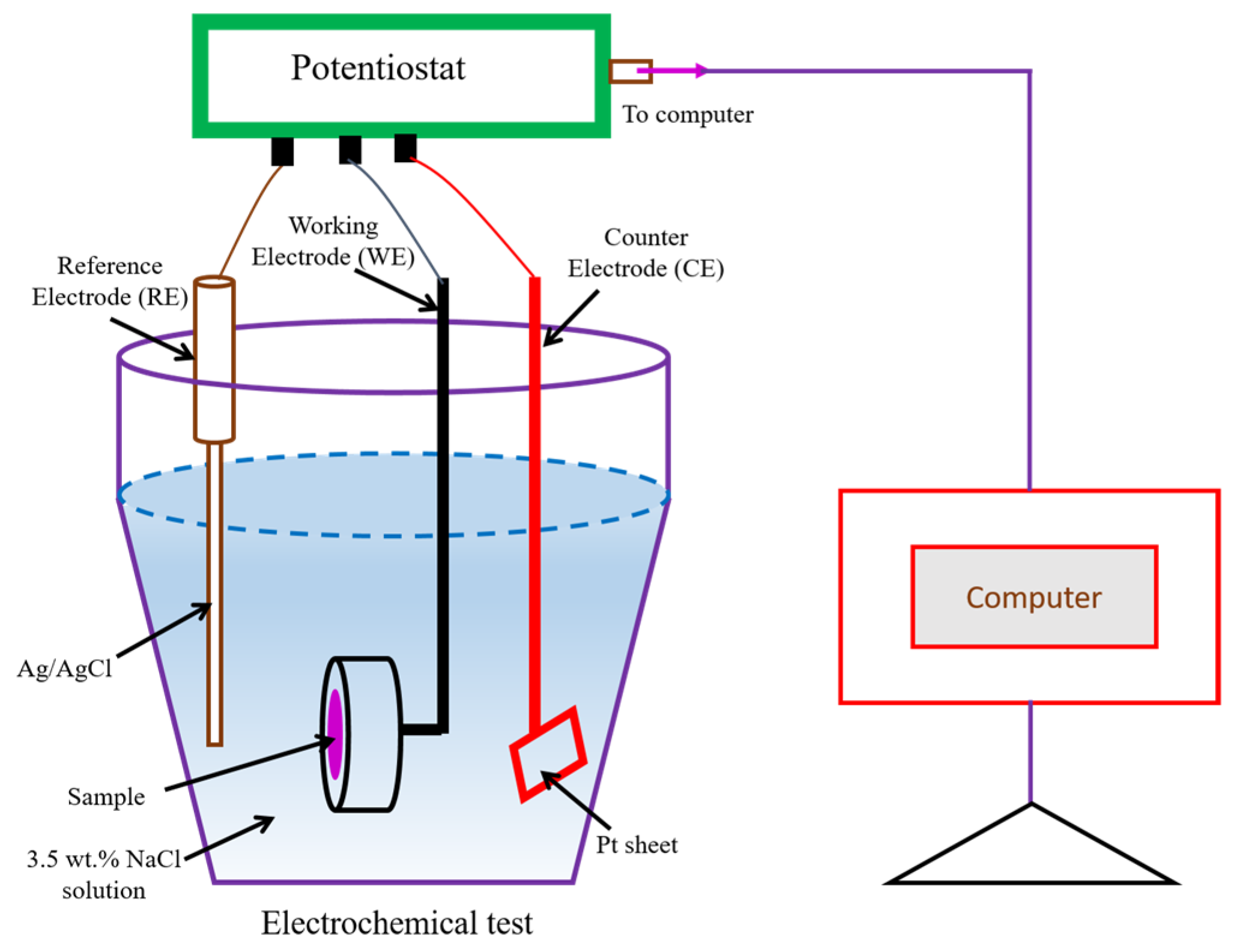
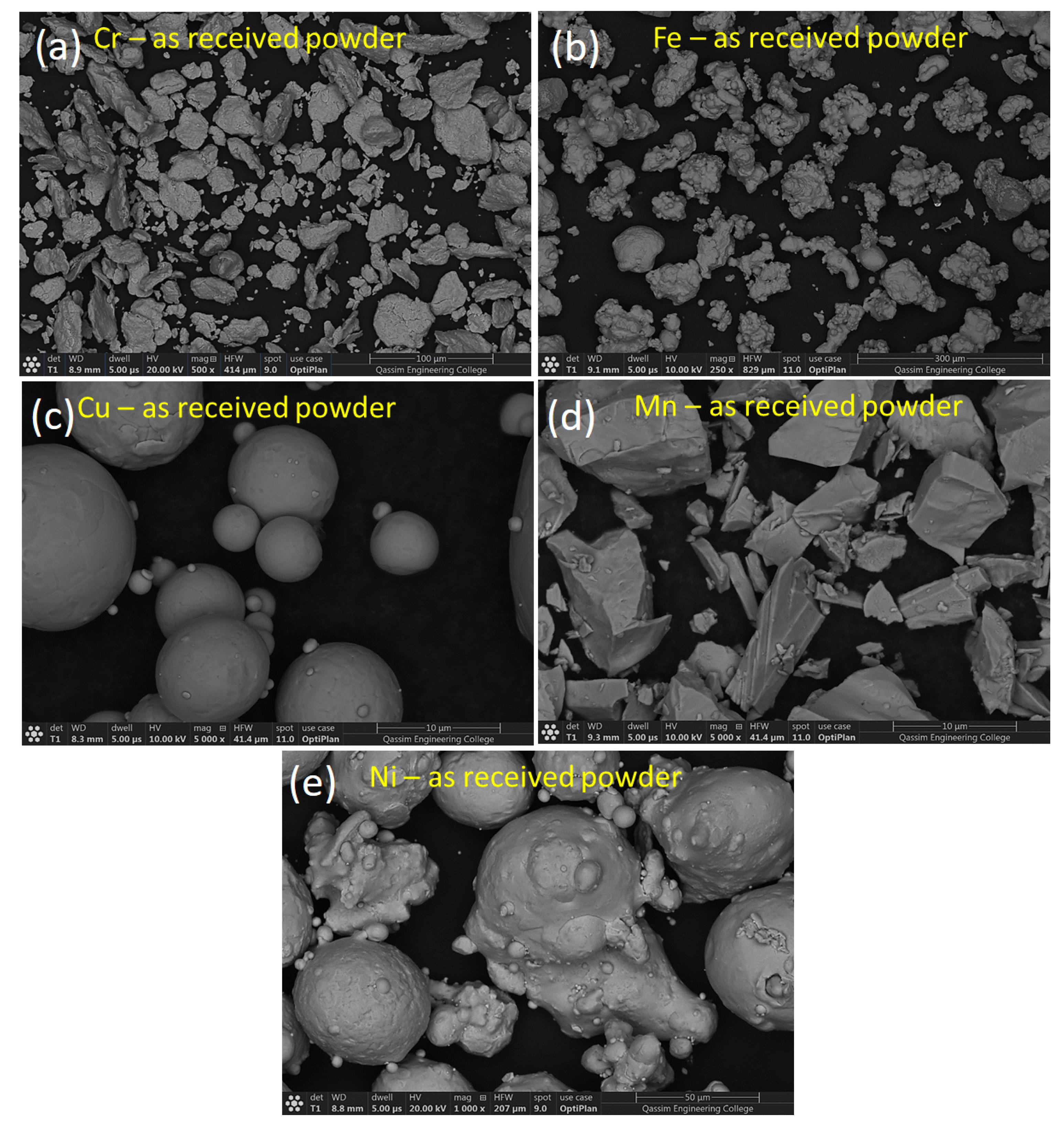
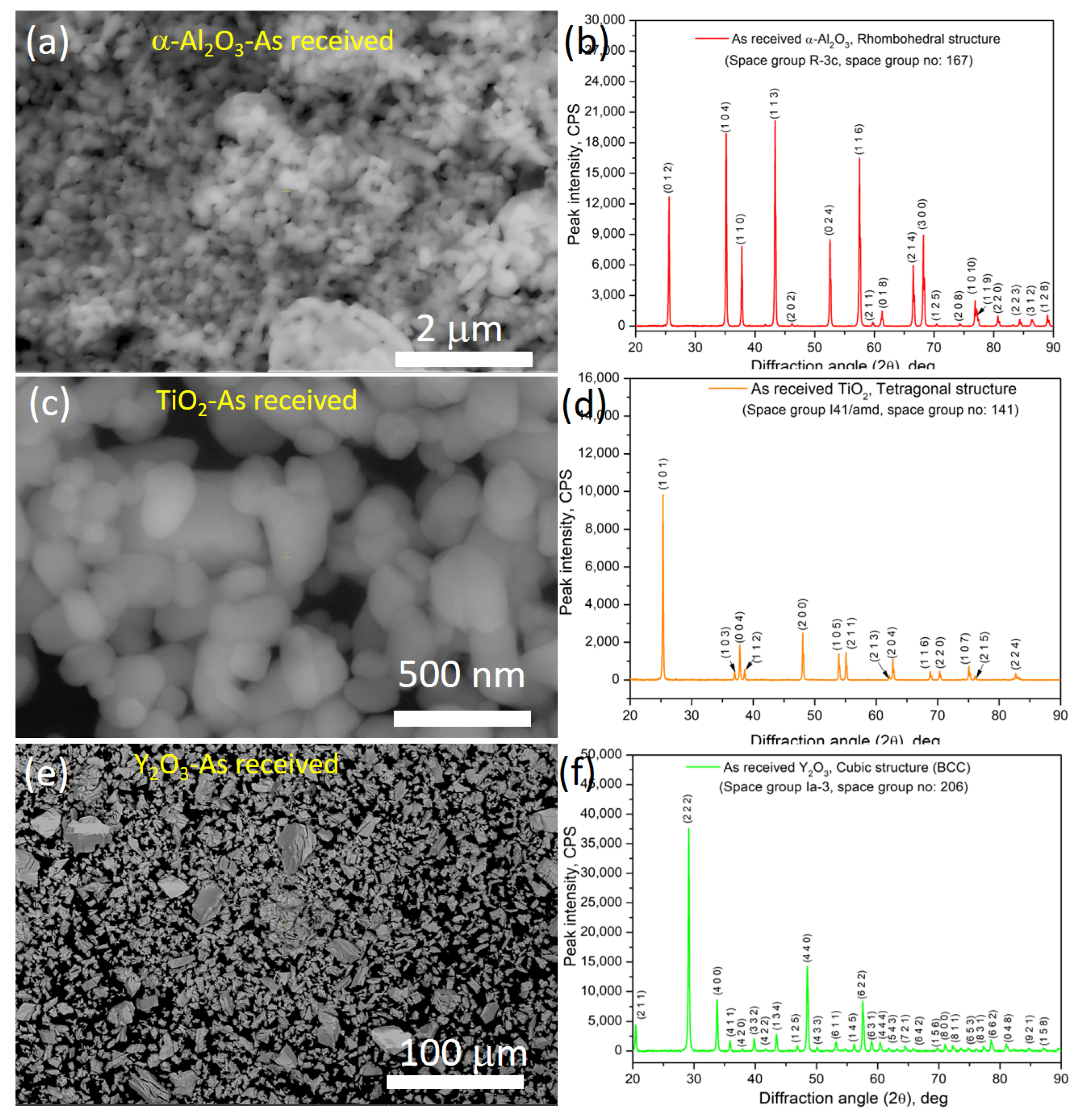
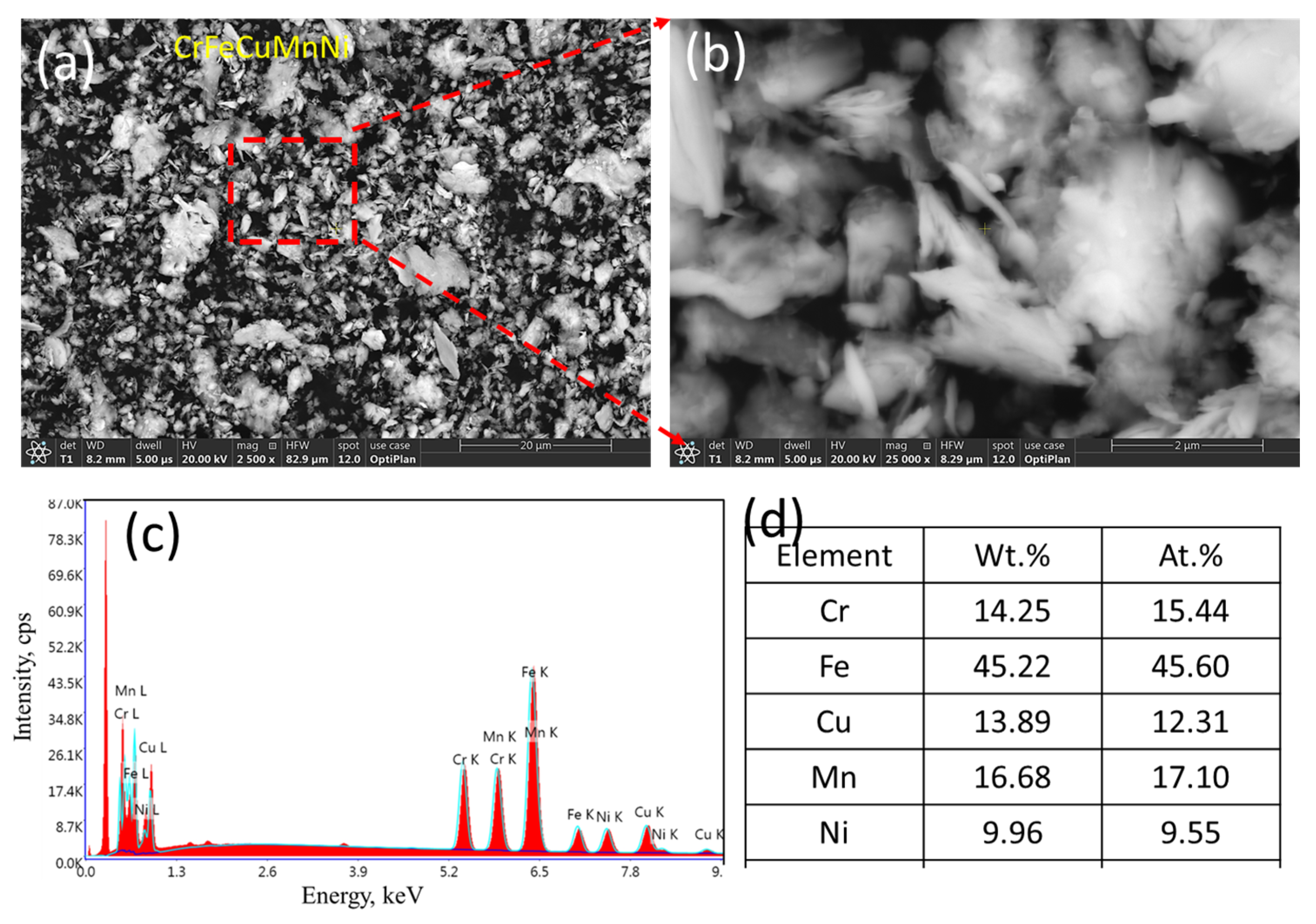
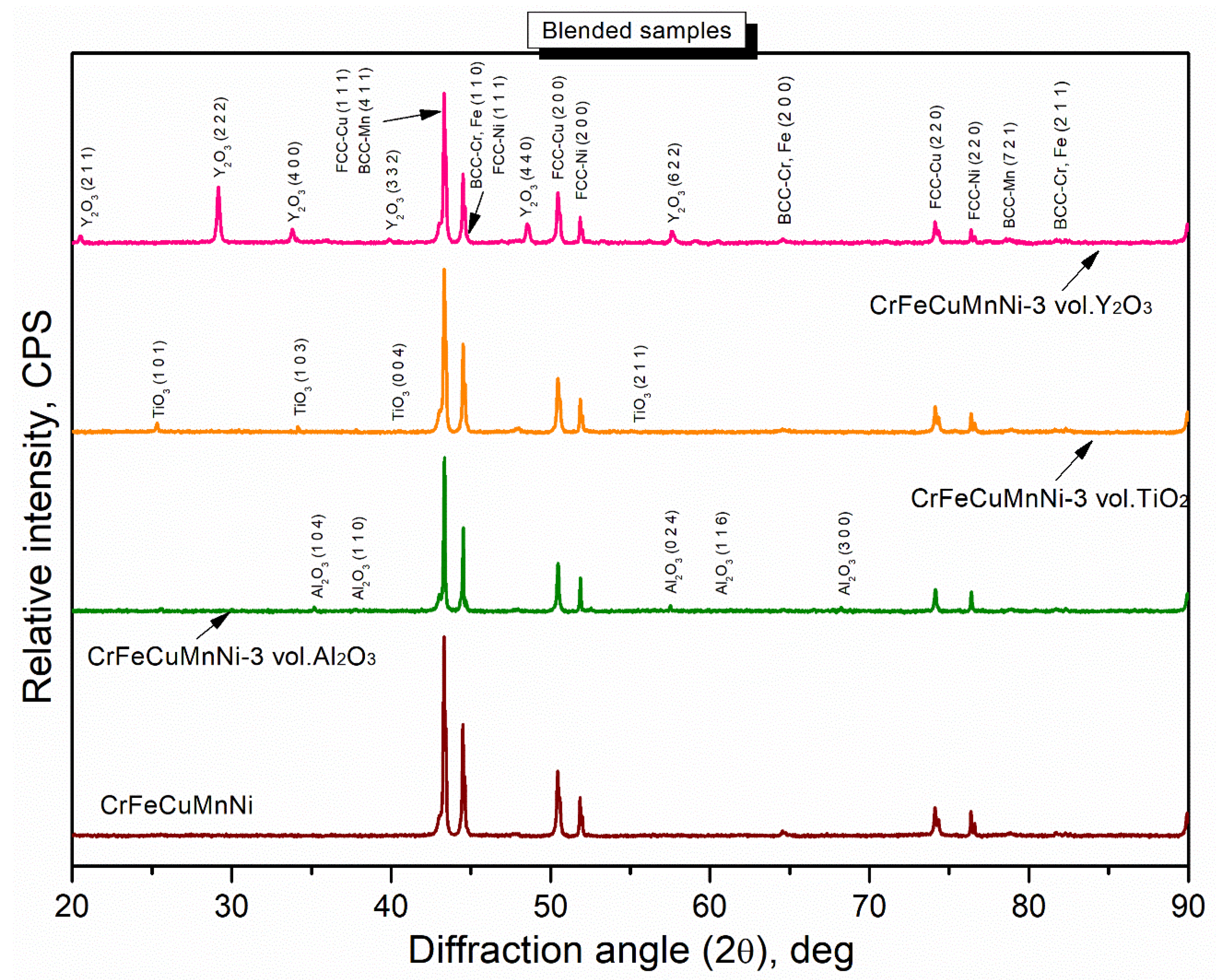











| Name of Sample (ID) | Cr | Fe | Cu | Mn | Ni | Reinforcements | ||||||
|---|---|---|---|---|---|---|---|---|---|---|---|---|
| at.% | wt.% | at.% | wt.% | at.% | wt.% | at.% | wt.% | at.% | wt.% | at.% | wt.% | |
| CrFeCuMnNi | 0.200 | 0.196 | 0.200 | 0.182 | 0.200 | 0.223 | 0.200 | 0.193 | 0.200 | 0.206 | 0.000 | 0.000 |
| CrFeCuMnNi-3 A2O3 | 0.194 | 0.186 | 0.194 | 0.173 | 0.194 | 0.211 | 0.194 | 0.186 | 0.194 | 0.195 | 0.030 | 0.052 |
| CrFeCuMnNi-3 TiO2 | 0.194 | 0.188 | 0.194 | 0.175 | 0.194 | 0.214 | 0.194 | 0.185 | 0.194 | 0.197 | 0.030 | 0.042 |
| CrFeCuMnNi-3 Y2O3 | 0.194 | 0.175 | 0.194 | 0.162 | 0.194 | 0.198 | 0.194 | 0.172 | 0.194 | 0.183 | 0.030 | 0.109 |
| Name of Element | Atomic Radius, nm | Crystal Structure | Melting Point (°C) | Valence Electron Concentration (VEC) | Theoretical Density, g/cm3 |
|---|---|---|---|---|---|
| Cr | 0.140 | BCC | 1538 | 8 | 7.140 |
| Fe | 0.140 | BCC | 1907 | 6 | 7.874 |
| Cu | 0.135 | FCC | 1084 | 11 | 8.920 |
| Mn | 0.140 | FCC | 1246 | 7 | 7.260 |
| Ni | 0.135 | FCC | 1455 | 10 | 8.908 |
| α-Al2O3 | - | Rhombohedral | 2072 | - | 3.987 |
| TiO2 | - | Tetragonal | 1843 | - | 4.260 |
| Y2O3 | - | Cubic | 2425 | - | 5.010 |
| Alloy | βc/ mV·dec−1 | ECorr/ mV | βa/ mV·dec−1 | jCorr/ µA·cm−2 | EProt./ mV | EPit./ mV | RP/ Ω·cm2 | RCorr/ mmpy |
|---|---|---|---|---|---|---|---|---|
| CrFeCuMnNi | 180 | −470 | 190 | 150 | −220 | −70 | 267.92 | 1.769 |
| CrFeCuMnNi-3 vol.% Al2O3 | 170 | −380 | 180 | 125 | −180 | −50 | 304.10 | 1.474 |
| CrFeCuMnNi-3 vol.% Y2O3 | 165 | −350 | 170 | 110 | −135 | −35 | 330.95 | 1.297 |
| CrFeCuMnNi-3 vol.% TiO2 | 170 | −340 | 180 | 50 | −120 | −30 | 760.25 | 0.589 |
| Name of Sample | RS/Ωcm2 | Q | RP1/ Ω cm2 | Cdl/ F cm−2 | RP2/ Ω cm2 | |
|---|---|---|---|---|---|---|
| YQ/Fcm−2 | n | |||||
| CrFeCuMnNi | 5.139 | 0.012140 | 0.47 | 29.26 | 1.705 × 10−5 | 173.9 |
| CrFeCuMnNi-3 vol.% Al2O3 | 6.081 | 0.003579 | 0.54 | 146.5 | 0.001657 | 448.9 |
| CrFeCuMnNi-3 vol.% Y2O3 | 6.172 | 0.002135 | 0.56 | 430.5 | 0.004481 | 1651 |
| CrFeCuMnNi-3 vol.% TiO2 | 6.628 | 0.001826 | 0.60 | 1243 | 0.000380 | 2349 |
| CrFeCuMnNi | At.% | 1 | 2 | 3 | 4 | 5 | 6 | 7 | 8 |
| O | 46.34 | 45.74 | 14.72 | 59.18 | 43.65 | 57.2 | 32.84 | 41.94 | |
| Na | 2.24 | 1.05 | - | - | 3.43 | 2.63 | 2.76 | 4.55 | |
| Cl | 2.93 | 11.19 | 14.32 | 1.15 | 1.53 | 1.5 | 5.86 | 7.72 | |
| Cr | 1.83 | 0.5 | 1.44 | 7.08 | 18.09 | 2.99 | 7.17 | 1.44 | |
| Mn | 9.12 | 7.4 | 18.01 | 4.47 | 4.87 | 1.27 | 10.93 | 5.94 | |
| Fe | 31.91 | 22.13 | 41.77 | 18.78 | 22.92 | 25.61 | 23.19 | 26.69 | |
| Ni | 5.08 | 5.52 | 7.18 | 2.71 | 2.89 | 1.07 | 14.93 | 7.99 | |
| Cu | 0.55 | 6.47 | 2.56 | 6.63 | 2.62 | 7.73 | 2.32 | 3.73 | |
| CrFeCuMnNi-3 vol. % Al2O3 | At.% | 1 | 2 | 3 | 4 | 5 | 6 | 7 | 8 |
| O | 21.96 | 49.75 | 54.67 | 37.27 | 44.01 | 56.85 | 56.05 | 65.47 | |
| Al | 0.16 | 0.01 | 0.1 | 0.02 | 1.93 | 3.06 | 0.34 | 2.03 | |
| Na | - | 0.89 | - | - | - | 1.08 | 1.35 | 1.85 | |
| Cl | 0.28 | 9.92 | 7.1 | 47.31 | 8.68 | 0.22 | 4.85 | 4.2 | |
| Cr | 5.77 | 1.36 | 1.79 | 0.3 | 9.73 | 18.27 | 0.91 | 0.93 | |
| Mn | 7.91 | 5.2 | 2.79 | 13.33 | 5.75 | 9.93 | 3.8 | 3.07 | |
| Fe | 37.33 | 25.29 | 27.58 | 0.51 | 17.85 | 2.14 | 18 | 13.99 | |
| Ni | 13.8 | 4.23 | 4.07 | 0.72 | 5.2 | 1.24 | 6.13 | 4.02 | |
| Cu | 12.79 | 3.35 | 1.9 | 0.54 | 6.85 | 7.21 | 8.57 | 4.44 | |
| CrFeCuMnNi-3 vol. % Y2O3 | At.% | 1 | 2 | 3 | 4 | 5 | 6 | 7 | 8 |
| O | 80.79 | 41.48 | 19.26 | 35.18 | 29.27 | 72.57 | 34.42 | 31.83 | |
| Y | - | - | 2.91 | 1.48 | 0.05 | - | 0.11 | 0.03 | |
| Na | - | 3.27 | - | - | - | - | - | - | |
| Cl | 1.43 | 0.11 | 0.36 | 0.88 | 3.73 | 3.77 | 15.03 | 15.18 | |
| Cr | 0.46 | 19.58 | 7.09 | 9.55 | 34.55 | 0.56 | 0.92 | 1.09 | |
| Mn | 3.51 | 6.5 | 11.3 | 15.35 | 6.95 | 2.76 | 11.74 | 8.43 | |
| Fe | 10.95 | 24.46 | 31.38 | 18.81 | 19.91 | 10.7 | 28.93 | 39.02 | |
| Ni | 2.31 | 2.42 | 14.89 | 9.33 | 2.96 | 6.93 | 5.37 | 3.28 | |
| Cu | 0.54 | 2.18 | 12.8 | 8.42 | 2.57 | 2.69 | 3.49 | 1.13 | |
| CrFeCuMnNi-3 vol. % TiO2 | At.% | 1 | 2 | 3 | 4 | 5 | 6 | 7 | 8 |
| O | 72.55 | 47.06 | 24.57 | 48.61 | 29.42 | 24.79 | 56.87 | 18.56 | |
| Ti | 0.12 | 0.38 | 0.24 | 0.16 | 0.3 | 1.13 | 2.11 | 2.04 | |
| Na | - | - | - | 0.11 | - | 0.87 | - | - | |
| Cl | 2.36 | 12.34 | 1.62 | 1.41 | 0.22 | 1.58 | 2.86 | 0.33 | |
| Cr | 0.57 | 2.88 | 7.84 | 3.46 | 10.75 | 7.78 | 22.32 | 6.85 | |
| Mn | 4.59 | 8.06 | 11.27 | 6.2 | 10.79 | 9.27 | 8.43 | 12.45 | |
| Fe | 15.08 | 23.07 | 32.55 | 29.92 | 30.01 | 40.17 | 6.45 | 30.87 | |
| Ni | 4.15 | 5.01 | 10.97 | 2.45 | 11.07 | 5.16 | 0.57 | 15.36 | |
| Cu | 0.57 | 1.2 | 10.95 | 7.63 | 7.42 | 9.21 | 0.43 | 13.52 |
Disclaimer/Publisher’s Note: The statements, opinions and data contained in all publications are solely those of the individual author(s) and contributor(s) and not of MDPI and/or the editor(s). MDPI and/or the editor(s) disclaim responsibility for any injury to people or property resulting from any ideas, methods, instructions or products referred to in the content. |
© 2023 by the authors. Licensee MDPI, Basel, Switzerland. This article is an open access article distributed under the terms and conditions of the Creative Commons Attribution (CC BY) license (https://creativecommons.org/licenses/by/4.0/).
Share and Cite
Sivasankaran, S.; Sherif, E.-S.M.; Ammar, H.R.; Alaboodi, A.S.; Mekky, A.-b.H. Influence of Oxide Dispersions (Al2O3, TiO2, and Y2O3) in CrFeCuMnNi High-Entropy Alloy on Microstructural Changes and Corrosion Resistance. Crystals 2023, 13, 605. https://doi.org/10.3390/cryst13040605
Sivasankaran S, Sherif E-SM, Ammar HR, Alaboodi AS, Mekky A-bH. Influence of Oxide Dispersions (Al2O3, TiO2, and Y2O3) in CrFeCuMnNi High-Entropy Alloy on Microstructural Changes and Corrosion Resistance. Crystals. 2023; 13(4):605. https://doi.org/10.3390/cryst13040605
Chicago/Turabian StyleSivasankaran, Subbarayan, El-Sayed M. Sherif, Hany R. Ammar, Abdulaziz S. Alaboodi, and Abdel-baset H. Mekky. 2023. "Influence of Oxide Dispersions (Al2O3, TiO2, and Y2O3) in CrFeCuMnNi High-Entropy Alloy on Microstructural Changes and Corrosion Resistance" Crystals 13, no. 4: 605. https://doi.org/10.3390/cryst13040605
APA StyleSivasankaran, S., Sherif, E. -S. M., Ammar, H. R., Alaboodi, A. S., & Mekky, A. -b. H. (2023). Influence of Oxide Dispersions (Al2O3, TiO2, and Y2O3) in CrFeCuMnNi High-Entropy Alloy on Microstructural Changes and Corrosion Resistance. Crystals, 13(4), 605. https://doi.org/10.3390/cryst13040605










